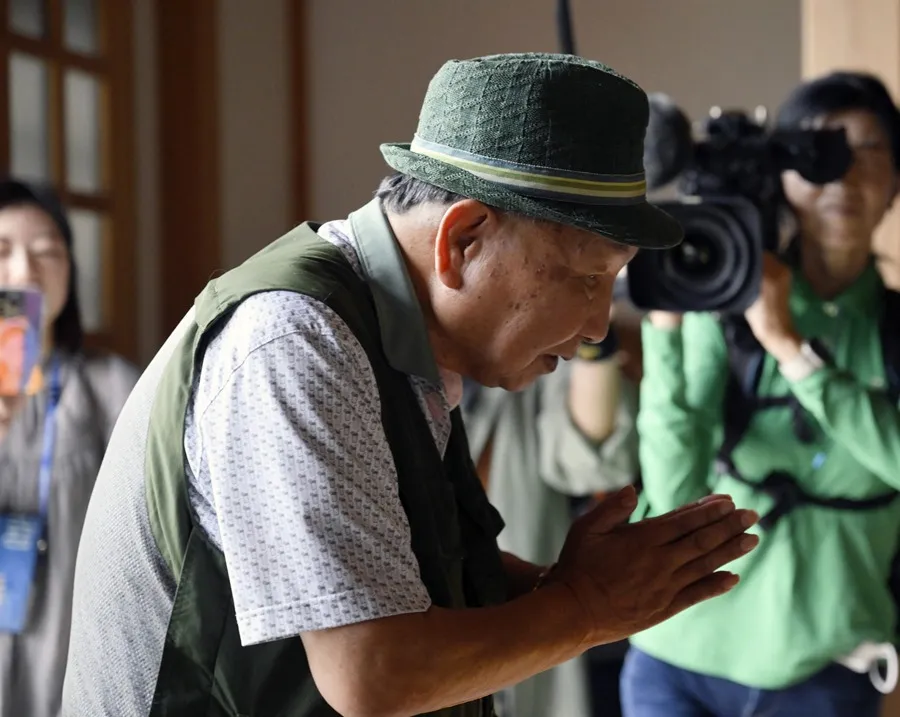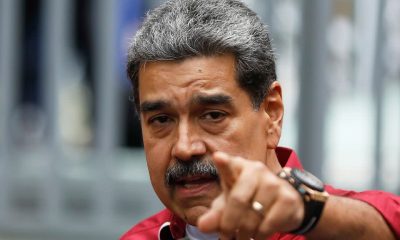International
Who is Iwao Hakamada, the inmate acquitted after 47 years waiting for a death sentence?

Former professional boxer, converted to Christianity in prison, Iwao Hakamada spent 47 years behing bars waiting for a death sentence that never came and from which the Japanese justice acquitted him this Thursday. It was the end of a tireless struggle to defend his innocence.
Hakamada (Shizuoka, 1936) was sentenced to death in 1968 after being accused of murdering two years earlier the owner of the miso factory (fermented soy) in which he worked, his wife and the couple’s two children and then burning his house.
He tirelessly defended his innocence on the grounds that the evidence that incriminated him was actually manufactured against him, mainly garments found in one of the company’s miso tanks, stained with blood and that matched his DNA. The Japanese justice has finally proved him right.
At 88 years old, with a weakened mental condition due to the almost half century he spent bands (so he holds a Guinness record), the Shizuoka District Court acquitted him this Thursday after the repetition of his trial, a procedure uncommon in Japan, but accepted for Hakamada in 2014.
The former Japanese boxer was released that year from prison, but the magistrates exempted him from appearing in the new trial due to his impaired mental condition. His sister, Hideko Hakamada, and his lawyer, Hideyo Ogawa, two of the pillars of the former convice, took over.
19 days and 228 hours of interrogation
Although he denied the facts when he was arrested in 1966, Hakamada took the charges on September 6 of the same year to “protect his life,” as he said at the time, on the nineteenth day of an interrogation that lasted an average of 12 hours a day.
He again denied having committed the crime in the first hearing of the initial trial and continued to do so in the thousand letters he sent to his family from prison.
The first was written in 1967 and was addressed to his mother, who died the following year although he did not know it until months later.
“It’s been half a year since I last saw you. I’m fine. I’m sorry my family is worried about me. I really have nothing to do with the Kogane Miso incident. I am innocent,” read the manuscript, compiled and published by the Japanese newspaper Asahi, along with the hundreds of letters that happened to the first one.
“They looked a little like my clothes, but there are so many clothes in the world that look like…”, Hakamada wrote before being sentenced in relation to the garments found in the miso tank.
Capital penalty
Hakamada was sentenced to death penalty because the blood with which the clothes found immersed in miso were stained matched his DNA, but the Japanese defended from the beginning that it was a fabricated evidence against him and appealed the sentence.
“I saw them (the blood-stained pants) in court. They seemed too small to me, no matter how I looked at them. If they don’t go well for me, the accusation against me will disappear,” Hakamada wrote in another of the letters to his family.
It was shown that the pants did not correspond to the size of the ex-contain, but the prosecutors and the authorities in charge of the investigation of the case argued that the clothes were small because Hakamada gained weight in prison.
Another of the former boxer’s arguments in the defense of his innocence was that the color of the blood was too dark, a thesis that prosecutors and investigators refuted claiming that the red had acquired a brownish tone by soaking the clothes in miso.
The appeal was rejected, but Hakamada requested in 1981 the repetition of the trial of his case, which was not accepted until 2014, after the prosecution revealed color photographs of the clothing that made the Shizuoka Court doubt the veracity of the evidence due to the color of the blood.
Hakamada’s release was ordered by the Japanese justice 17,388 days after his arrest, when a second trial was accepted, and the Japanese was released from prison at the age of 78.
A life in freedom with his sister
At the current age of 88, Hakamada lives in Hamamatsu, a city located in Shizuoka Prefecture, southwest of Tokyo, with his sister Hideko, three years older than him.
He continues to show symptoms of the “institutional psychosis” that was diagnosed in 2008, a mental illness that some prisoners develop and that manifests itself in the form of dizziness, headaches, nausea and paranoia. He also claims to be God.
International
Archbishop Wenski criticizes Trump’s deportation policies, calls for stronger push for reform

The Archbishop of Miami, Thomas Wenski, has called for increased pressure on the U.S. Congress to advance comprehensive immigration reform and criticized President Donald Trump’s mass deportation policies, arguing that they “do nothing to help.”
“We need to apply more pressure on Congress so lawmakers can make the necessary changes. It is also important for the Administration to listen to our voice. We do not want to be anyone’s enemy—we are Americans,” Wenski said in an interview with EFE.
The religious leader, who heads one of the dioceses with the largest Latino and Haitian populations in the United States, issued a call to defend the rights of migrants. He also emphasized that the U.S. Conference of Catholic Bishops (USCCB) has maintained a strong and public stance in favor of migrants for decades.
International
Trump relaunches diplomatic push to finalize U.S.-Backed peace plan for Ukraine War

U.S. President Donald Trump announced on Tuesday that his diplomatic team will resume meetings with delegations from Russia and Ukraine in an effort to pressure both sides to accept the peace plan proposed by Washington to end the war in Ukraine.
As part of this new round of talks, U.S. Special Envoy Steve Witkoff will travel to Moscow to meet with Russian President Vladimir Putin. Meanwhile, Army Secretary Dan Driscoll will hold discussions with Ukrainian representatives to narrow differences on the remaining points of the agreement.
Trump also confirmed his intention to meet personally with Ukrainian President Volodymyr Zelensky and with Putin, though he emphasized that such meetings will only take place “when the agreement is fully finalized or in its final stage.”
The president claimed that his administration has made “tremendous progress” toward resolving the conflict and reiterated that the war “never would have started” if he had been in the White House at the onset of the crisis.
The U.S.-backed peace plan consists of 28 points and has been revised following feedback from both sides. According to Trump, only “a few points of disagreement” remain under active discussion.
One of the most controversial aspects of the proposal is the suggestion that Ukraine cede parts of the Donbas region to Russia and limit the size of its armed forces. Kyiv is working closely with Washington to soften these clauses in search of an arrangement that does not compromise its sovereignty or security.
With this diplomatic push, Trump aims to solidify his role as the main mediator in the conflict and steer the war toward a political resolution after years of devastation, humanitarian crisis, and rising global geopolitical tensions.
International
Man pleads not guilty in Liverpool parade incident that injured more than 130

Paul Doyle, who has been held in provisional detention since the incident, is accused of intentionally injuring 12 people, attempting to injure another 17, and committing acts of violence and dangerous driving.
According to prosecutors, eight of the victims were minors at the time, including a six-month-old baby.
Wearing a black suit, the 54-year-old defendant broke into tears as the jury entered Liverpool Crown Court, in northwest England. Doyle, a father of three and former member of the Royal Navy, had pleaded not guilty in September to the 31 charges against him.
On Tuesday, he reaffirmed his not-guilty plea when asked to respond again to four of the charges, which had been slightly amended. The jury was sworn in the same day, and the trial—expected to last three to four weeks—will begin on Wednesday.
The incident occurred on May 26, when thousands of Liverpool FC supporters were gathered for a parade celebrating the club’s Premier League victory. According to the investigation, Doyle’s car entered a street that had just been reopened to allow an ambulance through.
His vehicle was then surrounded by a crowd of Liverpool supporters, some of whom acted aggressively. Doyle first reversed, then accelerated forward, swerving and striking people on both sides of the street. According to an initial report from Merseyside Police, 134 people were injured.
Firefighters reported that one man was thrown onto the hood of the vehicle and four people, including a child, were trapped underneath the car.
Doyle was arrested at the scene. Police quickly ruled out any terrorist motive, stating instead that it was an isolated incident.
-

 International4 days ago
International4 days agoTatiana Schlossberg reveals aggressive leukemia diagnosis in personal New Yorker essay
-

 International4 days ago
International4 days agoDeadly crash in Santa Bárbara leaves eight victims as campaign activities conclude
-

 International3 days ago
International3 days agoTrump relaunches diplomatic push to finalize U.S.-Backed peace plan for Ukraine War
-

 International5 days ago
International5 days agoColombia rescues 17 minors linked to ultra-orthodox sect Lev Tahor
-

 International4 days ago
International4 days agoTrump attacks Europe and Biden on Truth Social ahead of talks on Ukraine peace plan
-

 International5 days ago
International5 days agoOver 450 bags of human remains found near Jalisco’s World Cup stadium
-

 International4 days ago
International4 days agoPeru’s president says he is open to entering mexican embassy to arrest Betssy Chávez
-

 International4 days ago
International4 days agoWhite House considered dropping leaflets over Caracas to pressure Maduro
-

 International4 days ago
International4 days agoZelensky hails ‘important steps’ in Geneva talks but says more needed for real peace
-

 International3 days ago
International3 days agoMan pleads not guilty in Liverpool parade incident that injured more than 130
-

 International3 days ago
International3 days agoBolsonaro misses appeal deadline, faces imminent prison order by Brazil’s Supreme Court
-

 International4 days ago
International4 days agoSnapchat begins age verification for australian teens ahead of strict social media ban
-

 International3 days ago
International3 days agoMacron to announce new voluntary military service amid rising security concerns in Europe
-

 International4 days ago
International4 days agoInvestigations continue after mexican naval vessel’s deadly collision with bridge in New York
-

 Central America1 day ago
Central America1 day agoPanama reinforces security with new helicopters and Super Tucano Aircraft purchases
-

 Central America1 day ago
Central America1 day agoTrump urges hondurans to back conservative candidate Nasry Asfura in november elections
-

 International1 day ago
International1 day agoArchbishop Wenski criticizes Trump’s deportation policies, calls for stronger push for reform
-

 Central America1 day ago
Central America1 day agoWashington calls for oversight as Honduras faces allegations of electoral interference






























